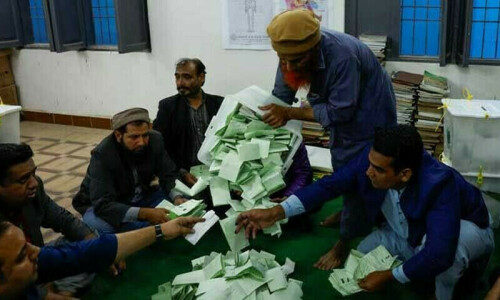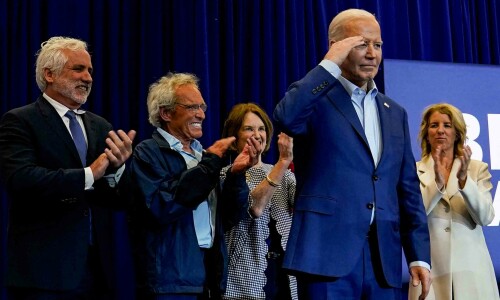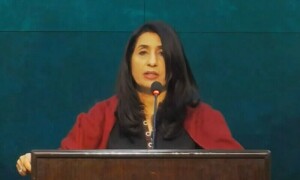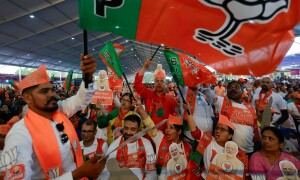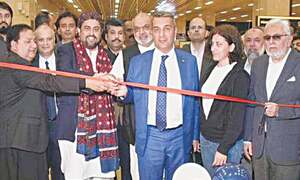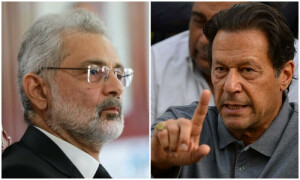
Do you remember words like gapastic, loafer, chughad, ahmaq, ullu ka patha and char sau bees or 420? When people described their spouses as begum or ghar wali instead of meri wife and meray shohar instead of meray husband. Language does not simply convey information, but carries social identities, cultural values, moral norms and self-awareness.
So much gets lost in the urge to be urbane that the present is only linked to an imagined future rather than also a carrying forward of historical cultural practices. In this confusion, people clap during qawwalis and classical music concerts as the etiquette of appreciation becomes obscured.
Mushairas are the last bastion of ‘Wah!’ The phrases for expressing appreciation or ‘daad dena’ of a couplet are ‘wah wah’, ‘bahut khoob’, ‘Sub’haan-Allah’, ‘kamaal kar diya, Sahib’, ‘zaraa misra tau uthaaiye Sahib!’
I remember going many years ago to the poet, Tanvir Anjum’s book launch at Fehmida Riaz’s publishing house, Waadah. Nearly 10 or 15 people — all friends — sat around a long table. After the social niceties were over, the official business of the day began. Tanvir read out some of her poems, and various critiques were given — some harsh — and a number of questions were posed. After the formalities were over, everyone reverted to socialising again.
Are visual artists more vulnerable to critique than poets? Is it the nature of art that it is meant to be silently absorbed and appreciated? There is also, of course, the matter of sale of artworks.
It was my first such experience. It immediately struck me how different it was from the opening of an art exhibition, where the artist anxiously looks at facial expressions and eavesdrops on comments to get some indication of whether the work met with approval or not. Occasionally artists such as Naiza Khan and Samina Mansuri would invite art students to comment on their work on one of the days after the private view. However, it is rare to hear questions or comments directed to the artist. Instead a comments book is placed for visitors. Most artists have to wait for the critic’s review that follows in the press.
Are visual artists more vulnerable to critique than poets? Is it the nature of art that it is meant to be silently absorbed and appreciated? There is also, of course, the matter of sale of artworks. There is an unspoken etiquette at private views to not express negative comments in case it adversely affects a potential buyer of the work.
In the past — when art followed prescribed rules — there was more immediate and vocal appreciation or criticism. It was customary for the Mughal emperor to present robes of honour or jewellery in appreciation to an artist, musician or dancer, whose skills were appreciated, and equally, one presumes, to dismiss an artist who displeased. In1863, the artist who came to be known as Impressionists were disbarred from exhibiting by the jury of the official Paris Salon.
Napoleon III intervened, arranging their work to be exhibited in another building known to history as the Salon des Refusés, so the public could be the judge of them.
When Marcel Duchamp’s ‘Nude Descending a Staircase’ was exhibited in New York in 1913, it was very publicly derided with cartoons and parodies and was called “an explosion in a shingle factory” by the art critic of The New York Times.
As art became more experimental, more conceptual, it also became more inaccessible to general visitors. Even art critics made great efforts to develop terminologies to explain the intention of the artist rather than present a personal opinion.
The general visitor can feel daunted by the cultivated mystique of the art gallery and hesitates to comment or ask questions for fear of appearing foolish.
When the visitor can see the artwork being made, or be present at an art performance, they are able to respond emotionally rather than only intellectually. This is something most people are more familiar with in performance-based art such as theatre, dance, music or poetry. This has encouraged galleries and museums to have open studios, where visitors can follow the work in progress.
Koel Gallery recently held open studios which drew a lot of interest from visitors. Sadeqain’s on-the-spot work and public murals may be one of the reasons he became so widely known and accessible. Artists who work in public spaces report a lot of interest, especially water colourists.
The artist Sara Khan recounted how she was sketching a policeman who was writing a challan with one knee on his motorcycle. A bit suspicious he walked over to her, but when he saw she was only making a sketch, he went back and posed for her so she could complete the drawing.
The art gallery should be a place to exchange ideas, meet up with colleagues and build up a community. Ultimately, exhibiting art is a gesture of communication, and the artist does want to know the work he or she invested so much time and emotion in, did communicate something to the viewer or evoked interest. A simple “Tell me about your work” may suffice to encourage the artist to explain the underlying ideas in the art works.
The artist is, after all, waiting for a ‘Wah!’ And a mukarrar irshaad in the form of the next exhibition.
Durriya Kazi is a Karachi-based artist and heads the department of visual studies at the University of Karachi
Published in Dawn, Sunday Magazine February 5th, 2017


















